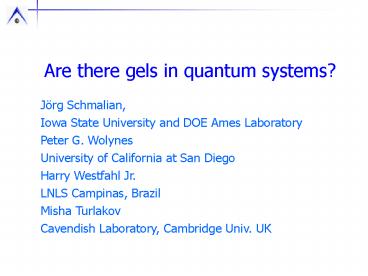Are there gels in quantum systems
1 / 14
Title:
Are there gels in quantum systems
Description:
Frustrated phase separation in microemusions and copolymers. Wu, Westfahl, Schmalian, ... surfactant mediated interaction. Real space. glassiness and entropy crisis ... –
Number of Views:36
Avg rating:3.0/5.0
Title: Are there gels in quantum systems
1
Are there gels in quantum systems?
Jörg Schmalian, Iowa State University and DOE
Ames Laboratory Peter G. Wolynes University of
California at San Diego Harry Westfahl Jr. LNLS
Campinas, Brazil Misha Turlakov Cavendish
Laboratory, Cambridge Univ. UK
2
reversible association of aggregates in
copolymers
Classical gels
chemical gels
physical gels
irreversible covalent cross-linking(vulcanization
)
weak crystals and glassy states
random solid
3
Complex aggregates form glassy states
Frustrated phase separation in microemusions and
copolymers
Wu, Westfahl, Schmalian, Wolynes, Chem. Phys.
Lett. (2002))
Most systems crystallize easily (under shear),
there are glass forming systems S.-H. Chen et al.
Science (2003)
4
A simple model
- phase A
- phase B
- Phase separation
coulomb interaction surfactant mediated
interaction
new length scale
Real space
5
glassiness and entropy crisis
trapped in a metastable state
complex energy landscape
In equilibrium scan the entire landscape
stripe liquid
Loss of entropy
exponentially many metastable states
breakdown of thermodynamics ( becomes
extensive)
6
deep in the glass state Memory effects
typical liquid configuration
7
Quantum gels (1) cuprates
- Our initial motivation
- charge order in transition metal oxides
- NMR extremely slow relaxation
- ? glassiness
- Glassiness intrinsic, tied to unconventional
properties of cuprates
Is there a universal origin for glassiness?
Panagopoulos et al. (2001))
8
Inhomogeneousspectral features(J. C. Davis et
al. Science (2001))
High-temperature superconductors
65 mV
01025d02 avg delta
30 mV
0 Å 140 Å
?
1.5 nS
01025d02 neg val
0.7 nS
A(?)
9
Self generated stripe glass
J.S. and P. Wolynes Phys. Rev. Lett. 85, 836
(2000) H. Westfahl Jr., J. S., and P. G.
Wolynes, Phys. Rev. B 64, 174203 (2001) ibid.
Intl. J. Mod. Phys. B 15, 3292 (2001) , ibid
Phys, Rev. B 68, 134203 (2003)
Using
Yamada et al. PRB (1998)
Stripe liquid
SC
AF
Stripe glass
region 10 (20) times lm contains 6 (106) states
10
(J. S. and M. Turlakov, Phys. Rev. Lett. (2004))
Quantum gels (2) MnSi, magnetic rotons
MnSi no-inversion symmetry
helical magnet
true non Fermi liquid behavior
11
magnetic rotons (J.S. and M. Turlakov) dramatic
increase in the phase space of magnetic
excitations due to helix fluctuations
- fluctuation induced 1st order transition
- non-Fermi liquid transport
- Amorphous ordering of helices at high pressure
(roton glass)
neutron scattering (C. Pfleiderer et al. Nature
(2004) )
12
relation to MnSi
ordinary second order transition
anomalous transport due to amorphous helical order
speculate anomalous Hall effect
13
Quantum melting of a stripe glass
quantum glass
quantum liquid
mixed state (at T0)
unique (pure) ground state
discontinuous transition
Liquid droplet formation and coexistence of
liquid and glass at the quantum melting point !
14
Conclusions
- Competing interactions in correlated electron
systems can lead to non-equilibrium dynamics in
quantum systems and glassy behavior not
necessarily related to quenched disorder































